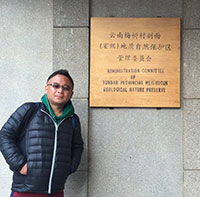 Xianfeng Yang. Yunnan Key Laboratory for Palaeobiology, Institute of Palaeontology, Yunnan University, 650500 Kunming, Yunnan, China and MEC International Joint Laboratory for Palaeobiology and Palaeoenvironment, Yunnan University, 650500 Kunming, Yunnan, China. (Corresponding author) 279751300@qq.com
Xianfeng Yang. Yunnan Key Laboratory for Palaeobiology, Institute of Palaeontology, Yunnan University, 650500 Kunming, Yunnan, China and MEC International Joint Laboratory for Palaeobiology and Palaeoenvironment, Yunnan University, 650500 Kunming, Yunnan, China. (Corresponding author) 279751300@qq.com
Xianfeng received a Ph.D degree from the institute of Nanjing geology and paleontology CAS and is a researcher and associate professor at the Yunnan University. His work mainly focusses on the paleoecology and paleontology of the Chengjiang biota, along with Cambrian trilobite biostratigraphy.
![]()
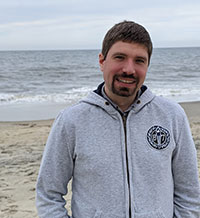 Julien Kimmig. Abteilung Geowissenschaften, Staatliches Museum für Naturkunde Karlsruhe, Karlsruhe, 76133, Germany and The Harold Hamm School of Geology & Geological Engineering, University of North Dakota, Grand Forks, North Dakota 58202, USA. (Corresponding author) julien.kimmig@smnk.de
Julien Kimmig. Abteilung Geowissenschaften, Staatliches Museum für Naturkunde Karlsruhe, Karlsruhe, 76133, Germany and The Harold Hamm School of Geology & Geological Engineering, University of North Dakota, Grand Forks, North Dakota 58202, USA. (Corresponding author) julien.kimmig@smnk.de
Julien Kimmig is the Head of the Paleontology Division at the State Museum of Natural History in Karlsruhe, Germany and an Associate Research Professor at the The Harold Hamm School of Geology & Geological Engineering, University of North Dakota. He has dedicated a large portion of his research to the understanding of the taphonomy and taxonomy of early Paleozoic Lagerstätten. He is also interested in museum collections, their history and their future.
![]()
 Christopher B. Cameron. Université de Montréal, Département de sciences biologiques, C.P. 6128, Succ. Centre-ville, Montréal, QC, H3C 3J7, Canada. c.cameron@umontreal.ca
Christopher B. Cameron. Université de Montréal, Département de sciences biologiques, C.P. 6128, Succ. Centre-ville, Montréal, QC, H3C 3J7, Canada. c.cameron@umontreal.ca
Christopher Cameron is a full professor in the département des sciences biologiques, Université de Montréal. His academic focus and expertise lie primarily in the origins and evolution of animal body plans, with a significant publication record in the comparative morphology and development, phylogenetics, fluid mechanics and palaeontology of marine invertebrates. He holds an NSERC Discovery grant that supports his research on extracellular matrix structures, including the gill bars, tubes, and skeletons of hemichordates, echinoderms and chordates. He has been at the Université de Montréal since 2006 and has supervised a substantial number of post-doctoral fellows, graduate students, and undergraduate students. In Québec, he works to braid indigenous knowledge with western science as a contributor to the annual Indigenous Science Fair.
![]()
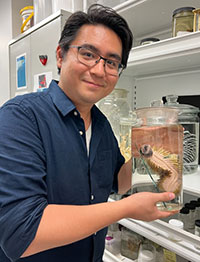 Karma Nanglu. Museum of Comparative Zoology and Department of Organismic and Evolutionary Biology, Harvard University, 26 Oxford Street, Cambridge, Massachusetts 02138, USA. knanglu@fas.harvard.edu
Karma Nanglu. Museum of Comparative Zoology and Department of Organismic and Evolutionary Biology, Harvard University, 26 Oxford Street, Cambridge, Massachusetts 02138, USA. knanglu@fas.harvard.edu
Karma Nanglu is a postdoctoral researcher at Harvard University and the Museum of Comparative Zoology. His research focuses on the origins of animal life from the perspective of how their early ecosystems were structured, as well as their evolutionary roots. He completed his PhD at the University of Toronto, and was previously a Peter Buck Deep Time postdoctoral fellow at the Smithsonian National Museum of Natural History.
![]()
 Sara R. Kimmig. Karlsruhe Institute of Technology (KIT), Institute of Geography and Geoecology, Reinhard-Baumeister-Platz 1, 76131 Karlsruhe, Germany. sara.kimmig@kit.edu
Sara R. Kimmig. Karlsruhe Institute of Technology (KIT), Institute of Geography and Geoecology, Reinhard-Baumeister-Platz 1, 76131 Karlsruhe, Germany. sara.kimmig@kit.edu
Sara Kimmig is a post-doctoral researcher in the Institute for Geography and Geoecology at the Karlsruhe Institute of Technology. Her research interests include applying non-CHONS isotopes as tracers in multiple systems including nutrient cycling, dolomite formation, and paleoenvironmental reconstructions as well as for environmental remediation and industrial signatures purposes.
![]()
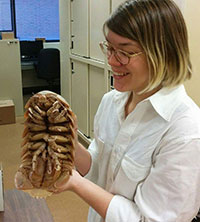 Danielle de Carle. Department of Ecology and Evolutionary Biology, University of Toronto, 25 Willcocks Street, Toronto, ON, M5S 2B4, Canada. danielle.decarle@mail.utoronto.ca
Danielle de Carle. Department of Ecology and Evolutionary Biology, University of Toronto, 25 Willcocks Street, Toronto, ON, M5S 2B4, Canada. danielle.decarle@mail.utoronto.ca
Danielle de Carle is a researcher and lecturer at the University of Toronto. She works on leech systematics and the evolution of complex traits, such as blood feeding.
![]()
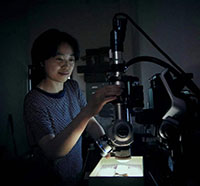 Caixia Zhang. Yunnan Key Laboratory for Palaeobiology, Yunnan University, North Cuihu Road 2, 650091, Kunming, China and MEC International Joint Laboratory for Palaeobiology and Palaeoenvironment, Yunnan University, 650091, Kunming, China. fyz@mail.ynu.edu.cn
Caixia Zhang. Yunnan Key Laboratory for Palaeobiology, Yunnan University, North Cuihu Road 2, 650091, Kunming, China and MEC International Joint Laboratory for Palaeobiology and Palaeoenvironment, Yunnan University, 650091, Kunming, China. fyz@mail.ynu.edu.cn
Caixia Zhang is a PhD student at the Yunnan Key Laboratory for Palaeobiology, Institute of Palaeontology, Yunnan University, studying the evolution of early arthropods from the Chengjiang biota, mainly bivalved arthropods-Isoxys.
![]()
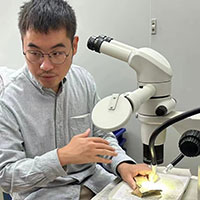 Mengxiao Yu. Yunnan Key Laboratory for Palaeobiology, Yunnan University, North Cuihu Road 2, 650091, Kunming, China and MEC International Joint Laboratory for Palaeobiology and Palaeoenvironment, Yunnan University, 650091, Kunming, China. ymx720@126.com
Mengxiao Yu. Yunnan Key Laboratory for Palaeobiology, Yunnan University, North Cuihu Road 2, 650091, Kunming, China and MEC International Joint Laboratory for Palaeobiology and Palaeoenvironment, Yunnan University, 650091, Kunming, China. ymx720@126.com
Mengxiao Yu is a PhD student at Yunnan University. He works on euarthropods in the Chengjiang Biota, such as Naraoia.
![]()
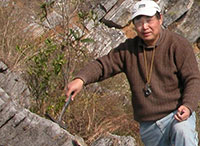 Shanchi Peng. State Key Laboratory of Palaeobiology and Stratigraphy, Chinese Academy of Sciences, Nanjing, 210008, China. scpeng@nigpas.ac.cn
Shanchi Peng. State Key Laboratory of Palaeobiology and Stratigraphy, Chinese Academy of Sciences, Nanjing, 210008, China. scpeng@nigpas.ac.cn
Shanchi Peng is a research professor at the State Key Laboratory on Palaeobiology and Stratigraphy, Nanjing Institute of Geology and Palaeontology, Chinese Academy of Sciences. He works on Cambrian trilobites mainly from South China, and global and regional chronostratigraphic subdivision of the Cambrian System.

